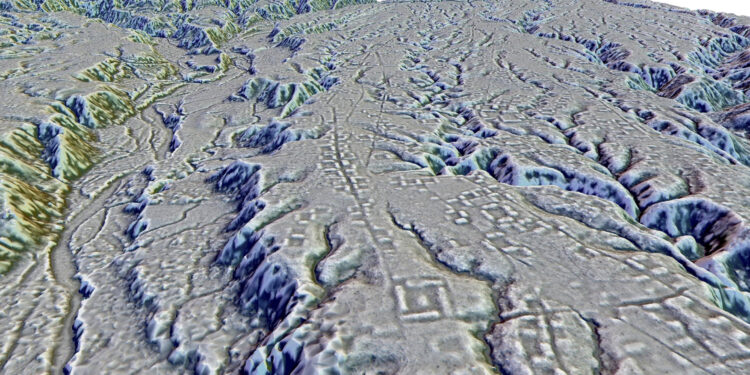This LIDAR image provided by researchers in January 2024 shows complexes of rectangular platforms arranged around low plazas and distributed along wide carved streets at the Kunguints site in Ecuador’s Upano Valley. Archaeologists have discovered a group of lost cities in the Amazon rainforest that were home to at least 10,000 farmers around 2,000 years ago, according to an article published Thursday, January 11, 2024, in the journal Science. Credits: Antoine Dorison, Stéphen Rostain via AP
Archaeologists have discovered a group of lost cities in the Amazon rainforest that were home to at least 10,000 farmers around 2,000 years ago.
A series of buried earth mounds and roads in Ecuador was first noticed more than two decades ago by archaeologist Stéphen Rostain. But at the time, “I didn’t really know how it all fit together,” said Rostain, one of the researchers who reported his findings Thursday in the journal Science.
Recent mapping using laser sensors has revealed that these sites were part of a dense network of settlements and connecting roads, nestled in the forested foothills of the Andes, that lasted for around 1,000 years.
“It was a lost valley of cities,” said Rostain, who leads the investigations at the National Center for Scientific Research. “It’s incredible.”
The settlements were occupied by the Upano people between about 500 BC and 300 to 600 AD, a period roughly contemporary with the Roman Empire in Europe, the researchers found.
Residential and ceremonial buildings erected on more than 6,000 earthen mounds were surrounded by agricultural fields with drainage canals. The largest roads were 10 meters wide and stretched 10 to 20 kilometers.
Although it is difficult to estimate the population, the site was home to at least 10,000 inhabitants, and perhaps as many as 15,000 or 30,000 at its peak, said archaeologist Antoine Dorison, co-author of the study from the same French institute. This is comparable to the estimated population of London in Roman times, then Britain’s largest city.
This LIDAR image provided by researchers in January 2024 shows a main street running through an urban area, creating an axis along which complexes of rectangular platforms are arranged around low plazas at the Copueno site in the Upano Valley in Ecuador. Archaeologists have discovered a group of lost cities in the Amazon rainforest that were home to at least 10,000 farmers around 2,000 years ago, according to an article published Thursday, January 11, 2024 in the journal Science. Credits: Antoine Dorison, Stéphen Rostain via AP
“It shows very dense occupation and an extremely complicated society,” said Michael Heckenberger, an archaeologist at the University of Florida who was not involved in the study. “For the region, it’s really in a class of its own in terms of earliness.”
José Iriarte, an archaeologist at the University of Exeter, said it would have taken a complex system of organized labor to build the roads and thousands of earth mounds.
“The Incas and Mayans built with stone, but the people of the Amazon generally didn’t have stone available to build with: they built with mud. That’s still an immense amount of work,” said Iriarte, who played no role in the research.
The Amazon is often considered “a pristine wilderness home to only small groups of people.” But recent discoveries have shown us how the past is actually much more complex,” he said.
Scientists have recently discovered evidence of complex rainforest societies that predate the arrival of Europeans elsewhere in the Amazon, including Bolivia and Brazil.
“There has always been an incredible diversity of people and habitats in the Amazon, not just one way of living,” Rostain said. “We’re just learning more about them.”
More information:
Stéphen Rostain et al, Two thousand years of garden-urban planning in Upper Amazonia, Science (2024). DOI: 10.1126/science.adi6317
© 2024 The Associated Press. All rights reserved. This material may not be published, broadcast, rewritten or redistributed without permission.
Quote: Archaeologists map the lost cities of the Ecuadorian Amazon, settlements that lasted 1,000 years (January 11, 2024) recovered on January 11, 2024 on
This document is subject to copyright. Apart from fair use for private study or research purposes, no part may be reproduced without written permission. The content is provided for information only.



